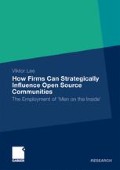Abstract
The literature on open innovation has revealed that firms are attracted by the idea of expanding their sources of innovation beyond the firm boundaries in virtual communities of interaction (Gangi and Wasko, 2009, Spaeth et al., 2010). Gangi and Wasko (2009) have proposed four major strategies to integrate external participants into the organizational innovation process: incorporating user toolkits, strategic positioning of personnel, engaging lead users, and implementing user innovation communities. The strategic positioning of personnel occurs when an “organization assigns and positions human resources in user innovation communities to capture the information flowing within the community and to influence the direction of the community's development efforts” (Gangi and Wasko, 2009: 209). The metaphor of the “man on the inside” (Dahlander and Wallin, 2006) refers to that strategic path. It is a phenomenon which can actually be observed in open source software communities. The term “man on the inside” describes a person who is part of a firm (bound by contracts, incentives or significant relations/importance to that firm) participating on behalf of a firm inside an open source community, as part of this professional role, in order to unlock assets that are being created within these communities. Firms strategically assign such persons to initiate and influence the development process of a product or service. Additional reasons why commercial firms participate in open source environments is the prospect of potential benefits that can be achieved through “external development support, setting a standard and enabling compatibility, increasing demand for complements, and signaling technical excellence or good OSS citizenship” (Henkel, 2008: 3). Despite the seemingly colliding conceptions of open source and commercialization around open source products, communities “enable firms to sponsor peers or allow personnel to work in the community” (Dahlander and Wallin, 2006: 1244). They are a key success factor in the process of building and growing an online community. In their work about firms trying to unlock communities as complementary assets, Dahlander and Wallin (2006) find that MOI are crucial individuals in the (GNOME) community, exhibiting significantly higher influence and connectivity in the community network compared to hobbyists. Henkel (2008) highlights a research gap regarding the roles of such employed developers.
Access this chapter
Tax calculation will be finalised at checkout
Purchases are for personal use only
Preview
Unable to display preview. Download preview PDF.
Rights and permissions
Copyright information
© 2012 Gabler Verlag | Springer Fachmedien Wiesbaden GmbH
About this chapter
Cite this chapter
Lee, V. (2012). Phenomenological background. In: How Firms Can Strategically Influence Open Source Communities. Gabler Verlag. https://doi.org/10.1007/978-3-8349-7140-1_2
Download citation
DOI: https://doi.org/10.1007/978-3-8349-7140-1_2
Publisher Name: Gabler Verlag
Print ISBN: 978-3-8349-3387-4
Online ISBN: 978-3-8349-7140-1
eBook Packages: Business and EconomicsBusiness and Management (R0)

